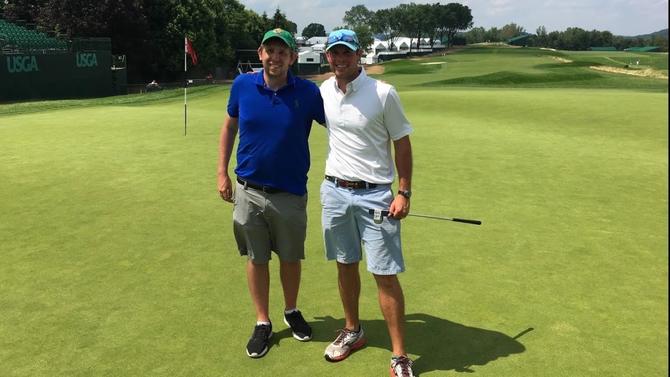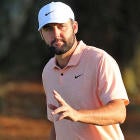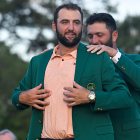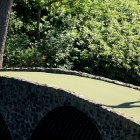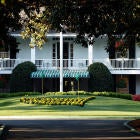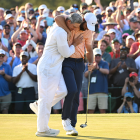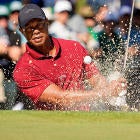When I received the email confirming that I had won the media lottery to play Oakmont Country Club on Monday after the U.S. Open, I didn't know whether to be elated that I was playing a course Golf Digest ranks No. 6 in the United States or terrified that I'm not sure I know what "9" looks like on the stimpmeter, much less double digits. I went with the former, and the scramble to find clubs and a ride to the course on Monday when the shuttles were no longer running was officially on.
My pal and ESPN writer Kevin Van Valkenburg gave me the ride I needed along with another ESPN writer Michael Collins. There was much excited chatter because Van Valkenburg and I had never played a course like this, but there was also a sense of impending doom. If Lee Westwood shot a 43 on the front nine with these pins on Sunday ... was a thought in the back of my head the entire way.
I got to the course three hours before my tee time because when you can hit balls on the range at Oakmont for an unspecified amount of time you hit balls on the range at Oakmont for the entirety of that unspecified time (also because Van Valkenburg and Collins had a tee time two and a half hours before mine).
I started grinding hard enough to potentially concern some of my colleagues who were also enjoying themselves on the range. I'm a 12-15 handicap (I don't have an official number), and I thought there was real potential for me to embarrass myself in front of my playing partners. That and the caddie I was provided might just leave my bag on one of the tee boxes and I would never see him again. So I made sure the swing was at least permissible.
The good folks of the USGA rounded up some TaylorMade clubs for me but no kicks so here I am playing one of the most famous courses on the planet -- site of nine U.S. Opens -- in my Mizuno running shoes. I believe this is what is called a first world problem. Van Valkenburg texted me after an hour. "Par on 2!" he wrote. "He must be playing from the women's tees," I thought.
Back to the grind.
We finally teed off at 10:30 a.m. after my Vijay Singh-like session on the range. I went into the round feeling better than I should have because we were only allowed to hit off mats on the range. The golf equivalent to playing on nine-foot basketball goals or flipping the bumpers up in bowling. Just a complete and total false confidence. But at least Oakmont isn't a place where false confidence can be exposed!
My playing partners were Luke Kerr-Dineen of For the Win, Ryan Ballengee of Golf News Net and Andy Vasquez of The Record (New Jersey). Good dudes all of them which is paramount when you're traipsing around Oakmont trying to find golf balls in rough as tall as Dash Day.
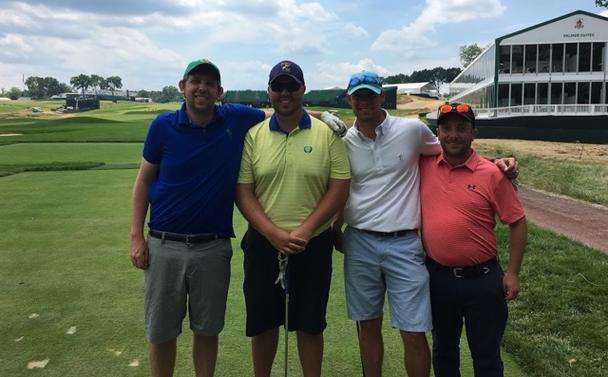
An Oakmont employee greeted us just beyond the clock on the first tee as our two caddies scrambled down the fairway to get eyes on what were sure to be four wayward drives. "What tees should we play?" someone asked. "Let's tip it out," someone else replied. "Get a feel for exactly how the course was playing on Sunday for the pros."
Sounds like either the best or worst idea ever.
So our Oakmont chaperone -- who said his personal record at the course was 66 (LOL) -- showed us to the championship tees. One of the coolest behind-the-scenes things I saw is that the tees for each round of the U.S. Open are actually marked by dots. One for Thursday. Two for Friday. It sounds inconsequential, but it looked awesome. We played the fours. Sunday tees. The greens were not cut or rolled, we were told, but the pins were in the same slots.
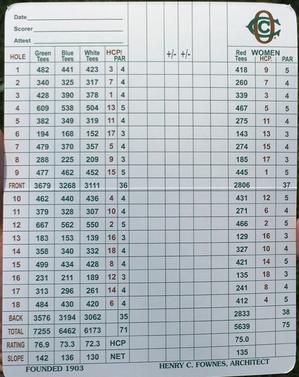
The chaperone gave us our line off No. 1, the 485-yard par 4 that played to a 4.23 stroke average on Sunday from the tees and pins we played. He laughed and said, "or ... you could take the Dustin Johnson line" and pointed to an area of the stratosphere with which I am unfamiliar. I asked him where the Andrew Landry line was. Then I hit the two best shots I would probably hit all day. Two putts for par.
I'm going to beat Lee Westwood's front nine and tweet my scorecard at him!
It went poorly from there. Bogey-bogey at the next two, and it went even more poorly from there. Oakmont is difficult not because of its glassy greens which our caddies told us were rolling at about a 12 on the stimp. Those were surprisingly not as difficult as I thought they would be. I think it's because if you hit your line, it's definitely going in. Finding the right line isn't easy, but it's certainly easier than keeping it between the first cut in the fairway.
Oakmont is difficult not because of its greens but because if you don't hit the fairway, you aren't making par. It makes what Dustin Johnson, who was the longest player in the field, did even more impressive. It's fine to be long, but it's not paramount. What is paramount is holding fairways to even give yourself a chance. Unfortunately this is not the "strong" part of my game (although to be fair, I'm not totally sure what is).
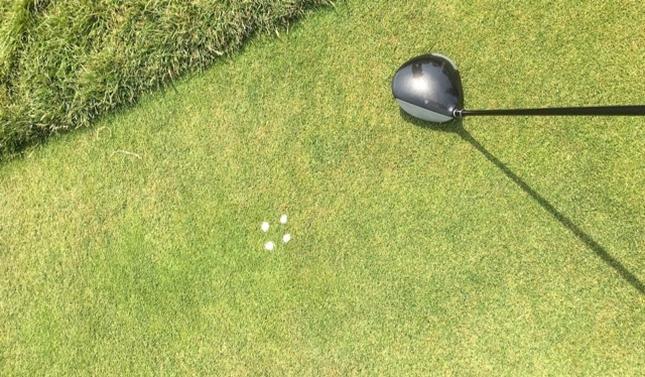
I'll tell my kids someday that I hit a ball in the church pews on No. 3 on purpose. I won't tell them about how I laid up on the 299-yard par 3. There was a social media shaming for the ages when I pulled 4-iron on the eighth hole. Hey, I'm staying in my lane! I'll give you 2,000 words on Dustin Johnson's triumph on Sunday night, but I cannot give you 300 yards with a baby draw with my 3-wood. That is not in my wheelhouse. Plus at that point, I was still trying to post a score. Have to tweet at Westwood, remember.
@LukeKerrDineen@KylePorterCBSpic.twitter.com/evemSkU8WW
— No Laying Up (@NoLayingUp) June 20, 2016
I shot a 50 on the front nine, third place in my group. I don't even feel like I hit it that poorly. But Oakmont is not a place where you can "not hit it that poorly." It got ugly in a hurry on the back nine. I ejected harder than Sergio Garcia in the hunt on a major Sunday with a couple of woozy quads in which I questioned whether I even still wanted to write about this sport in the future, much less play it.
My moment of the day (other than the par at No. 1) probably came on the par-5 12th. I had an out-of-body experience on the infamous tee box where Dustin Johnson had been informed of his potential penalty some 20 hours earlier. I pumped a tee shot into the no-divot zone and had 255 into the hole. Some math, thankfully done by me and not Austin Johnson, tells me that was a 363-yard drive. Of course I hit my approach hole high in the rough and made a six. But I'd made up for my indiscretion in laying up at a par 3 earlier in the round.
Luke and I had a flight to catch so we skipped Nos. 16-17 and played 18 coming home. As I stood on that box waiting for the fairway to clear thinking about how Johnson had drank in his first national championship less than 24 hours before I stood in that space, I couldn't help but think about the past week and past three years.
It's no small thing to get to cover the PGA Tour and specifically the majors. I value both a lot, and I'm glad for the venues I've gotten to frequent and the friends I've made. I could go another 100 lifetimes, and if things had gone slightly different at any point of my previous 31 years on earth, I wouldn't be standing on the tee box on the 18th hole at the U.S. Open the day after it was completed. At Oakmont of all places. A pelt-hanger that has no peer when it comes to Open venues. It's impossible not to be nostalgic in these moments.
But I filed the thought away and turned back to the course. I wanted birdie at the last. Make Adam Scott proud. Piped tee shot, decent approach that rolls off the green ... three putts for double bogey. "This round and this moment are both pretty awesome," I thought. "But dang, this course is really, really hard."
